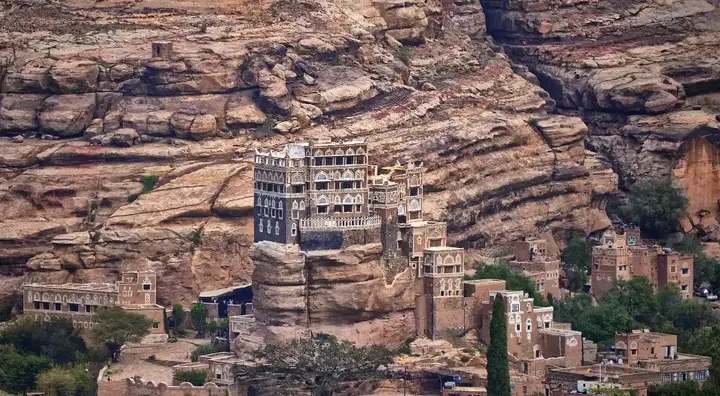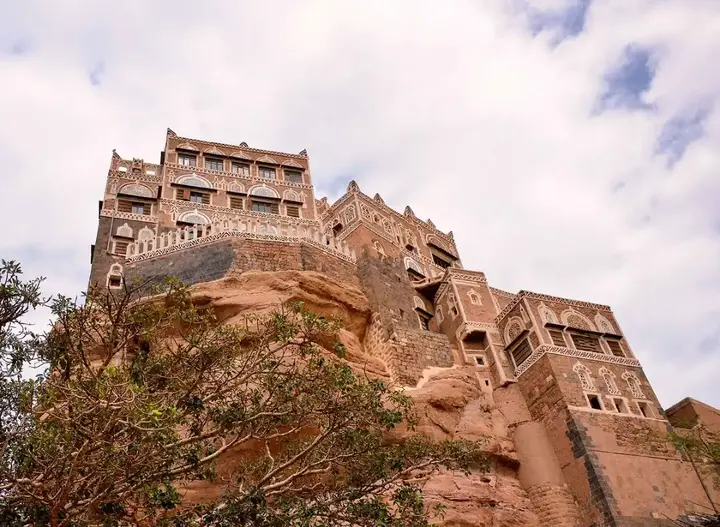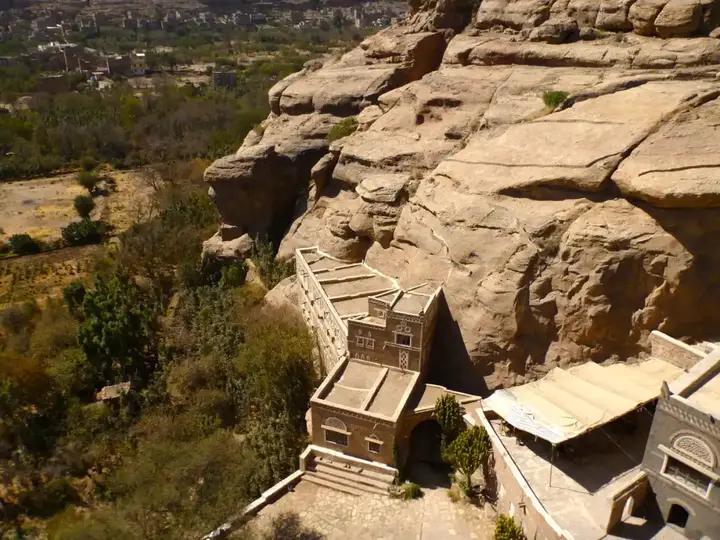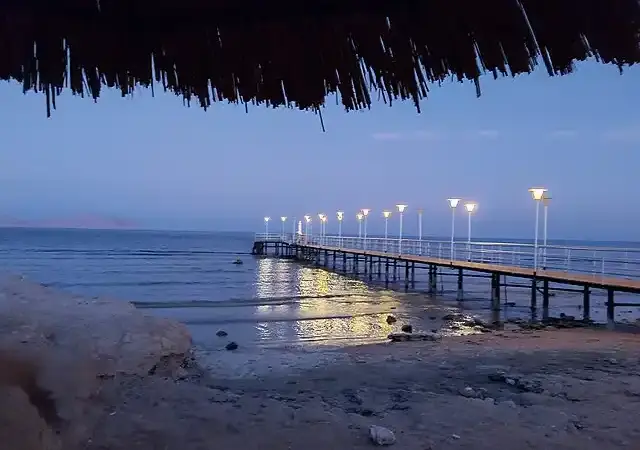Dar Al-Hajar ... The seven-story stone palace in Wadi Dhahr, Yemen
The Stone Palace, or as it is sometimes referred to as Dar al-Hajar or the Stone House, is a unique building located atop a large rock in Wadi Zahr, near the Yemeni capital Sana'a. This stone palace, which served as a summer residence for the Zaidi imam, Yahya Muhammad Hamid al-Din, is one of the greatest examples of traditional Yemeni architecture and architects disagree on the date of its construction, some saying it dates back hundreds of years and others say it began construction in the nineteenth century.
Show key points
- The Stone Palace, also known as Dar al-Hajar, is perched atop a massive rock formation in Wadi Zahr, near Sana'a, Yemen.
- Originally serving as the summer residence of King Yahya Muhammad Hamid al-Din, the palace exemplifies traditional Yemeni architecture.
- While the exact construction date is debated, it is widely believed to have been erected in the 1930s on top of an earlier structure from the 18th century.
- ADVERTISEMENT
- Designed like a fortified castle, the palace includes defensive features and an independent water source from beneath the rock.
- The interior boasts numerous facilities such as guest rooms, a Turkish bath, storage areas, and a garden with a 700-year-old tree.
- Now functioning as a museum, Dar al-Hajar attracts visitors globally despite travel advisories against entering Yemen.
- The palace remains a symbol of Yemen’s rich cultural history and is celebrated as a marvel of both engineering and artistic design.
The stone palace looks like a carved from the mountain

If you look at it from afar, it seems as if the stone palace came out of the mountain that carries itself, and it seems to be hundreds of years old, although it was built in the modern era, specifically sometime in the thirties of the nineteenth century AD. No source is clear whether newly built or simply added to an earlier structure that existed here, the stone palace has everything a single leader needs.
Recommend
The historical importance of the Stone Palace

Dar Al-Hajar Palace was the summer residence of former Yemeni King Yahya Muhammad Hamid al-Din. It was built in the twenties of the last century on top of a pre-existing stone structure believed to date back to the nineteenth century. The palace remained owned by the Yemeni royal family until 1962 and is now a museum and tourist attraction.
Location of the Stone Palace in Yemen

Located about nine miles from the capital Sana'a in Wadi al-Dhahr, which seems to be from another world, Dar al-Hajar dates back to the twenties of the last century, and was built as a summer residence for the Islamic spiritual leader and King Yahya Muhammad Hamid al-Din. But it was erected on top of a structure built on the rock column in 1786 by the Islamic scholar Imam Mansur Ali bin Mahdi Abbas.
Design of the Stone Palace

Inside the Stone Palace there are many guest rooms, kitchens, storage areas and quiet courtyards. It is definitely a pleasure for the eye to look at from the outside and inside, the stone palace is designed to be a fortified fortress that withstands attack and withstands long periods. It is built like a war castle, with firing positions to defend the place from attackers and its own water supply from the depths of the rock," meaning it could have "easily endured the siege".
The Stone Palace has a number of facilities such as appointment rooms, separate water cooling spaces in traditional earthen jars, guest rooms, Turkish bath, fountains and much more. There is a large garden at the entrance to the residence with a very old tree that is considered about 7 centuries old.
The Stone Palace in the Modern Era

Dar al-Hajar, owned by the government today, serves as an enticing museum that attracts people from all over the world who want to get as close as possible to Yemen's traditional architecture, while learning more about the modern history of Yemeni leaders, again at a time when the country had no king or president, but an Islamic spiritual leader leading the country. Now it is a museum, where visitors can wander the rooms and explore the maze of stairs. Unfortunately, the Foreign and Commonwealth Office advises against travel to Yemen. But this does not prevent us from admiring its treasures from afar. Overall, a true masterpiece of architectural marvel that will surely excite the imagination within visitors who can gaze at the oasis in which this charming stone palace is located.
![]()
Smart glasses help the sighted! A terrible scientific achievement!
AI-powered smart glasses are changing lives for the blind, offering independence through features like text reading, object and face recognition, navigation, and real-time translation. Though challenges like cost and privacy remain, users report life-changing benefits, and ongoing development promises even more possibilities for accessibility and inclusion. more- ADVERTISEMENT
![]()
Tigris and Euphrates: Lifelines in Mesopotamia
The Tigris and Euphrates rivers, known as the cradle of civilization, have shaped ancient Mesopotamian life and still power agriculture, trade, and electricity today. Flowing through Turkey, Syria, and Iraq, their waters remain vital but increasingly contested, urging regional cooperation for sustainable and fair resource sharing. more- ADVERTISEMENT
![]()
Nightlife and cafes in Sharm El Sheikh
Sharm El Sheikh transforms after sunset into a vibrant nightlife hub. From lively clubs in Naama Bay to traditional vibes in the Old Market, there's something for everyone. Enjoy beach parties, fine dining, and local culture, all while soaking in the electric energy of this Red Sea gem. more- ADVERTISEMENT
![]()
The biggest mystery in geology - when plate tectonics began to reshape the Earth
On February 6, 2023, a powerful earthquake struck the eastern Mediterranean, shifting the Anatolian Peninsula by 11 meters and killing nearly 60,000 people. This disaster highlights how tectonic plate movements reshape Earth's surface and cause devastating quakes by releasing built-up pressure at plate boundaries. more- ADVERTISEMENT
![]()
Navigating the Chaos: From Chaos to Stability in Life
Chaos is a natural part of life, often unavoidable but not unmanageable. With tools like mindfulness, time management, and support systems, individuals can reduce its impact and find stability. It's less about eliminating chaos and more about adapting to it wisely for a more balanced life. more- ADVERTISEMENT
![]()
The most impressed Japanese techniques in modern times
Japan keeps surprising the world with weird yet useful inventions—like heated toilet seats and noise-canceling forks. One standout? Healthcare robots that assist the elderly, making life easier and healthcare smarter. Also, karaoke, born in Japan, totally changed entertainment. It's clear: Japan knows how to mix fun, tech, and innovation. more- ADVERTISEMENT
![]()
Genetically engineered microbes: the future of sustainable agriculture
Genetically modified microbes are transforming farming by boosting crop growth, nutrient absorption, and resilience to stress. These tiny allies can cut chemical use, fight pests naturally, and even help tackle climate change—offering a smart, sustainable path forward for agriculture. more- ADVERTISEMENT
![]()
What makes the global demand for Arabic grow?
Arabic is booming globally, reflecting pride, rich culture, and growing global influence. With rising demand in business, media, internet, and diplomacy, Arabic is becoming essential in today’s world, offering vast opportunities for communication, jobs, and cultural exchange. more- ADVERTISEMENT
![]()
Saving our seas: Can we remove plastic pollution?
Plastic pollution is everywhere—from oceans to our drinking water. Ocean cleanup efforts like The Ocean Cleanup aim high but also come with side effects, including harming marine life and adding to carbon emissions. The real solution? Stop single-use plastic at the source before it ever reaches the sea. more- ADVERTISEMENT
![]()
Scientists wonder if the universe looks like a donut cake
Scientists are exploring the universe’s shape and structure, searching for signs of cosmic loops and mirrored galaxies. Using improved CMB maps and powerful telescopes, they aim to uncover if the universe is finite—and perhaps one day map it all, like a cosmic version of Google Earth. more- ADVERTISEMENT





















